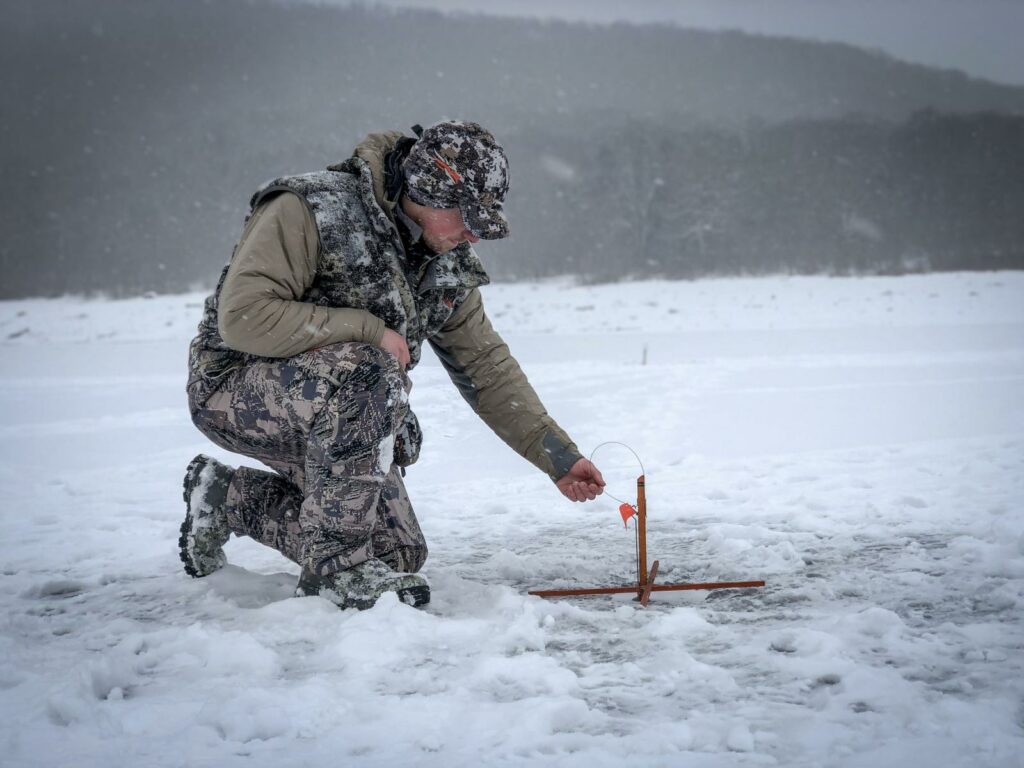It used to be a bummer for me when hunting season ends and we get into the dead of winter in northern Pennsylvania, but that all changed when I started ice fishing. Ice fishing can be hit or miss depending on the weather in the winter. You need to have cold weather for an extended period of time so that the ice is thick enough to walk out on. There are plenty of lakes and rivers in the PA Wilds that freeze enough to ice fish on at some point during the winter. If you are looking to break the cabin fever and get outside during the winter, you can have a chance at some big fish and can enjoy the experience with friends and family.

Plan Ahead
Before going ice fishing, you should pay attention to the weather and make sure it’s safe to go out. Even a few days with the weather above freezing temperatures could lead to the ice weakening. According to the Pennsylvania Department of Conservation & Natural Resources (DCNR), you should have at least 4 inches of ice for one person and at least 7 inches for a small group. You can test the ice thickness by drilling a hole with an auger close to shore. In addition to the ice thickness, ice fishing normally takes place in some frigid temperatures, so proper clothing layering is a must. If you were to fall through the ice, cotton clothing holds moisture and will result in hypothermia much quicker than synthetic or wool clothing, which will actually help you “cook” yourself dry as you walk back to your vehicle utilizing your own body heat as the oven.
Clothing recommendations
- Synthetic or wool base and mid layers will keep you warmer, and will be much better than cotton if you get wet. Synthetic clothing will dry fast, and wool will retain heat even when wet.
- Insulated jacket (one that is windproof will drastically improve your ability to maintain heat)
- Insulated pants or bibs
- An insulated hat – I like to use a wool hat that covers my ears to retain heat. You lose most of your heat through your head, hands and feet.
- Insulated boots that have traction on the slippery ice.
- A thin pair of wool gloves to work with and give dexterity, as well as insulated gloves or a hand muff to keep your hands warm while waiting.
Additional safety gear
- Ice picks – You wear these around your neck, which can be helpful if you fall through the ice and help you get a grip on the ice to pull yourself out.
- Personal flotation device (PFD) – This can be helpful for the group to have in case someone falls through the ice. The group can throw the PFD to the individual who fell in.
- Chemical hand warmers – These can keep you on the ice longer, and keep your hands, feet and body warm.
Once you get to the ice fishing location, you should take a look at the body of water and pay attention to areas where the ice might not be as thick. You should avoid these locations and use additional caution near them. These areas include:
- Where running water pours into the lake
- Areas where logs and brush stick out of the ice or water
- Areas with standing water on top of the ice
In addition to these areas, you should check the thickness of the ice regularly with changing temperatures throughout the day. Fish love structures such as the logs and brush that stick out of the ice, so make sure that if you are trying to fish these areas that you use extra caution.
Understanding the risks and knowing how to use your safety gear is critical in staying safe on the ice. Having a plan and maintaining caution at all times will not only keep you safe, but will most likely result in a more enjoyable experience. Ice fishing is by far one of my favorite outdoor activities to do in the winter, and would highly recommend others to give it a try.
For more information on ice fishing in Pennsylvania, check out this helpful resource from the PA Fish and Boat Commission. The PA Department of Conservation and Natural Resources also provides this resource for monitoring ice thickness and snowfall.




